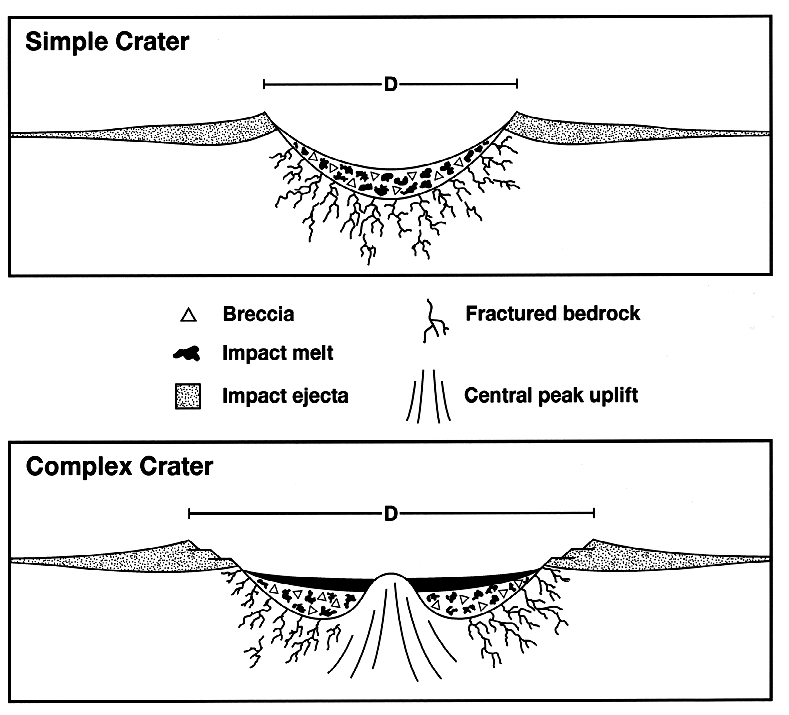
Complex crater
Encyclopedia

Impact crater
In the broadest sense, the term impact crater can be applied to any depression, natural or manmade, resulting from the high velocity impact of a projectile with a larger body...
morphology.
Above a certain threshold size, which varies with planetary gravity, the collapse and modification of the transient cavity is much more extensive, and the resulting structure is called a complex crater. The collapse of the transient cavity is driven by gravity, and involves both the uplift of the central region and the inward collapse of the rim. The central uplift is not the result of elastic rebound which is a process in which a material with elastic strength attempts to return to its original geometry; rather the collapse is a process in which a material with little or no strength attempts to return to a state of gravitational equilibrium.
Complex craters have uplifted centers, and they have typically broad flat shallow crater floors, and terraced walls. At the largest sizes, one or more exterior or interior rings may appear, and the structure may be labeled an impact basin rather than an impact crater. Complex-crater morphology on rocky planets appears to follow a regular sequence with increasing size: small complex craters with a central topographic peak are called central peak craters, for example Tycho
Tycho (crater)
Tycho is a prominent lunar impact crater located in the southern lunar highlands, named after the Danish astronomer Tycho Brahe . To the south is the crater Street; to the east is Pictet, and to the north-northeast is Sasserides. The surface around Tycho is replete with craters of various sizes,...
; intermediate-sized craters, in which the central peak is replaced by a ring of peaks, are called peak-ring craters, for example Schrödinger
Schrödinger (crater)
Schrödinger is a huge lunar impact crater of the form traditionally called a walled plain and is named after Erwin Schrödinger. It is located near the south lunar pole on the far side of the Moon, and can only be viewed from orbit. The smaller crater Ganswindt is attached to the southwestern rim of...
; and the largest craters contain multiple concentric topographic rings, and are called multi-ringed basins, for example Orientale
Mare Orientale
Mare Orientale is one of the most striking large scale lunar features, resembling a target ring bull's-eye. Located on the extreme western edge of the lunar nearside, this impact basin is difficult to see from an Earthbound perspective.Material from this basin was not sampled by the Apollo program...
. On icy as opposed to rocky bodies, other morphological forms appear which may have central pits rather than central peaks, and at the largest sizes may contain very many concentric rings – Valhalla
Valhalla (crater)
Valhalla is the largest multi-ring structure on Jupiter's moon Callisto and in the Solar System. It was named after Valhalla, Odin's hall in Norse mythology. Valhalla consists of a bright central region 360 km across, an inner ridge and trough zone and striking concentric rings extending up...
on Callisto is the type example of the latter.
See also
- impact structureImpact structureThe term impact structure is closely related to the terms impact crater or meteorite impact crater, and is used in cases where erosion or burial have destroyed or masked the original topographic feature with which we normally associate the term crater...
- Traces of CatastropheTraces of CatastropheThe book Traces of Catastrophe: A Handbook of Shock-Metamorphic Effects in Terrestrial Meteorite Impact Structures, or more commonly shortened to Traces of Catastrophe, was written by Bevan M. French of the Smithsonian Institution. It is a comprehensive technical reference on the science of impact...
book from Lunar and Planetary InstituteLunar and Planetary InstituteThe Lunar and Planetary Institute is a scientific research institute dedicated to study of the solar system, its formation, evolution, and current state. The Institute is part of the Universities Space Research Association and is supported by the Science Mission Directorate of the National...
- comprehensive reference on impact crater science

